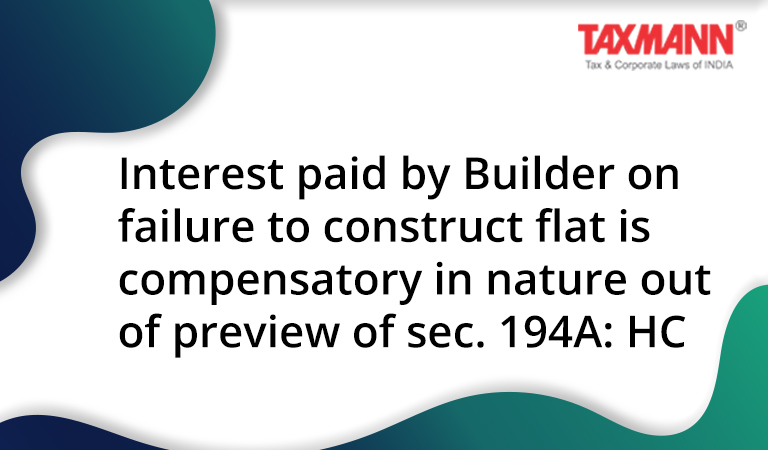Interest paid by Builder on failure to construct flat is compensatory in nature out of preview of sec. 194A: HC
- Blog|News|Income Tax|
- 3 Min Read
- By Taxmann
- |
- Last Updated on 9 November, 2021

Case Details: Sainath Rajkumar Sarode v. State of Maharashtra - [2021] 131 taxmann.com 332 (Bombay)
Judiciary and Counsel Details
-
- S.J. Kathawalla and Milind N. Jadhav, JJ.
- Subit Chakrabarti, Vidhii, P.H. Kantharia, Hemant Haryan, AGP, Zal Andhyarujina, Sr. Adv., Ms. Akanksha Agrawal, Makarand Raut, Akanksha Agrawal, Manoj Nikam, Anosh Sequiera and Naresh Chheda for the Appearing Parties.
Facts of the Case
The assessee was an individual who entered into an agreement with Builder for the purchase of various flats. However, the Builder failed to hand over possession of flats on time. Thus, Real Estate Regulatory Authority (RERA) directed Builder to refund the advance amount paid by the assessee with compensatory interest.
Builder deducted TDS under section 194A on the amount of compensatory interest paid to the assessee. The assessee filed the writ petition before the Bombay High Court, contending that tax deduction on the interest portion wasn’t in accordance with the law.
High Court Held
The Bombay High Court held that the term ‘interest’ is defined under section 2(28A) of the Income-tax Act. From such definition, it appears that the term ‘interest’ has been made entirely relatable to money borrowed or debt incurred and various gradations of rights and obligations arising from either of the two.
In the instant case, the assessee had not given the money to Builder by way of deposit, nor had the Builder borrowed the amount from the assessee. The sum paid to the assessee was a refund of the advance given to Builder. The interest was paid on account of damages suffered by the assessee for failure in delivering the flats.
Since the payment couldn’t establish a debtor-creditor relationship between the assessee and the Builder, the said sum or any part thereof cannot be liable to tax deducted at source under the relevant provisions of the Act.
Therefore, the provisions of Section 194A were not applicable, and the Builder was clearly wrong in deducting the TDS from the interest payable to the assessee.
Case Review
-
- Beacon Projects (P.) Ltd. v. CIT [2015] 62 taxmann.com 177/234 Taxman 706/377 ITR 237 (Ker.) (para 26);
- CIT v. HP Housing [2012] 18 taxmann.com 129/205 Taxman 1/340 ITR 388 (HP) (para 25);
- Pr. CIT v. West Bengal Housing Infrastructure Development Corpn. Ltd. [2019] 105 taxmann.com 64 (SC)
- Ghaziabad Development Authority v. Dr. NK Gupta 2002 SC Online NCDRC 39 (para 25) followed.
List of Cases Referred to
-
- All India Reporter Ltd. v. Ramchandra D Datar [1961] 41 ITR 446 (SC) (para 8)
- Madhusudan Shrikrishna v. Emkay Exports [2010] 188 Taxman 195 (Bom.) (para 8)
- Pr. CIT v. West Bengal Housing Infrastructure Development Corpn. [2018] 96 taxmann.com 610/257 Taxman 570/[2019] 413 ITR 82 (Cal.) (para 8)
- Pr. CIT v. West Bengal Housing Infrastructure Development Corpn. Ltd. [2019] 105 taxmann.com 64/263 Taxman 237 (SC) (para 8)
- Beacon Projects (P.) Ltd. v. CIT [2015] 62 taxmann.com 177/234 Taxman 706/377 ITR 237 (Ker.) (para 8)
- Estate Officer, Greater Mohali Area Development Authority v. Gaurav Mutneja 2020 SCC Online NCDRC 278 (para 10)
- Ghaziabad Development Authority v. Dr. NK Gupta 2002 SC Online NCDRC 39 (para 10)
- Ghaziabd Development Authority v. Naresh Kumar Sharma [2005] 9 SCC 477 (para 10)
- Rajnish Bhardwaj v. CHD Developers Ltd. 2019 SCC Online NCDRC 739 (para 10)
- Central India Spg. & Wvg. & Mfg. Co. Ltd. v. Municipal Committee
- Wardha AIR 1958 SC 341 (para 10)
- CIT v. HP Housing Board [2012] 18 taxmann.com 129/205 Taxman 1/340 ITR 388 (HP) (para 10).
Disclaimer: The content/information published on the website is only for general information of the user and shall not be construed as legal advice. While the Taxmann has exercised reasonable efforts to ensure the veracity of information/content published, Taxmann shall be under no liability in any manner whatsoever for incorrect information, if any.

Taxmann Publications has a dedicated in-house Research & Editorial Team. This team consists of a team of Chartered Accountants, Company Secretaries, and Lawyers. This team works under the guidance and supervision of editor-in-chief Mr Rakesh Bhargava.
The Research and Editorial Team is responsible for developing reliable and accurate content for the readers. The team follows the six-sigma approach to achieve the benchmark of zero error in its publications and research platforms. The team ensures that the following publication guidelines are thoroughly followed while developing the content:
- The statutory material is obtained only from the authorized and reliable sources
- All the latest developments in the judicial and legislative fields are covered
- Prepare the analytical write-ups on current, controversial, and important issues to help the readers to understand the concept and its implications
- Every content published by Taxmann is complete, accurate and lucid
- All evidence-based statements are supported with proper reference to Section, Circular No., Notification No. or citations
- The golden rules of grammar, style and consistency are thoroughly followed
- Font and size that’s easy to read and remain consistent across all imprint and digital publications are applied



 CA | CS | CMA
CA | CS | CMA
